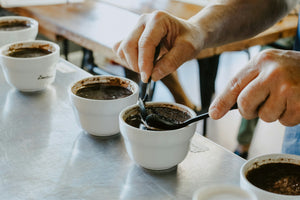The Complete Guide to Coffee Flavours: Identifying Notes and Nuances
Feb 12, 2024
If you’re a coffee lover, there's a good chance you're interested in exploring the vast rainbow of flavours encompassed within a singular and simple bean. Welcome to the journey and excitement of coffee tasting! This complete guide will dive deep into understanding the intricacies of coffee flavours, highlighting how you can identify various notes and nuances.
Recognising the unique elements in your cup of coffee transforms the regular morning ritual into an extraordinary everyday adventure. To begin this, let's start with understanding that coffee flavours are influenced by multiple factors. These include bean type, origin, processing method, roasting, grinding, and brewing techniques.
Understanding Coffee Flavour Profiles
A coffee flavour profile is essentially a sensory overview of the coffee – illustrated in the taste, aroma, mouthfeel, and acidity. These characteristics are impacted by geographical elements such as altitude, temperature, soil composition and rainfall, leading to distinctive traits in coffees grown in different parts of the world.
Beans from South America, for instance, often exude a rich, chocolaty flavour, whereas African beans project a variety of fruity and floral notes. Some Asian coffees have a robust earthiness to them, while Central American ones can present vibrant citrus flavours.

Decoding Your Coffee Tasting Notes
Tasting notes in coffee are subtle hints of flavours that can be identified when you sip your brew. They could echo enhancements of berries, chocolate, nuts, flowers, or an array of other flavours. Often, these tasting notes are directly linked to the unique characteristics of the region where the coffee is grown.
Recognising these tasting notes may take a little practice. Like wine tasting, it’s about being intentional and concentrating on what you’re experiencing in each sip. We recommend taking notes; jot down whether you're noticing bold vs. subtle flavours, fruits vs. spices and so forth.

The Role of the Roast
The roast level provides a significant influence on the flavour profile of the coffee. Light roasts usually maintain the original flavours of the bean and are often higher in acidity. They may offer vibrant floral or fruity notes. Dark roasts, conversely, acquire more flavour from the roasting process, delivering bold, smoky, or chocolaty flavours.

Grinding and Brewing Impact
How you grind and brew your coffee also plays a critical role in accentuating the flavour notes. The grind size can determine the extraction rate of the coffee, which directly influences the taste in your cup: a finer grind may lead to a full-bodied, bitter coffee, while a coarser grind is likely to deliver a lighter, more acidic brew.
When it comes to brewing methods, each has its impact on the flavour outcome. Brewing in a French press may enhance the body and richness of the coffee, while a pour-over method might highlight the subtle flavours and precise notes.
The coffee tasting journey can be a joyfully complex one, offering an array of flavours, notes, and nuances. Whether you are a seasoned coffee enthusiast or a curious beginner, this guide has everything you need. Remember, just like with any other culinary art, tasting coffee is a subjective experience. What's most important is that you savour and enjoy your brew – and don't be afraid to dive deeper into the flavourful abyss that is your next cup of coffee.

